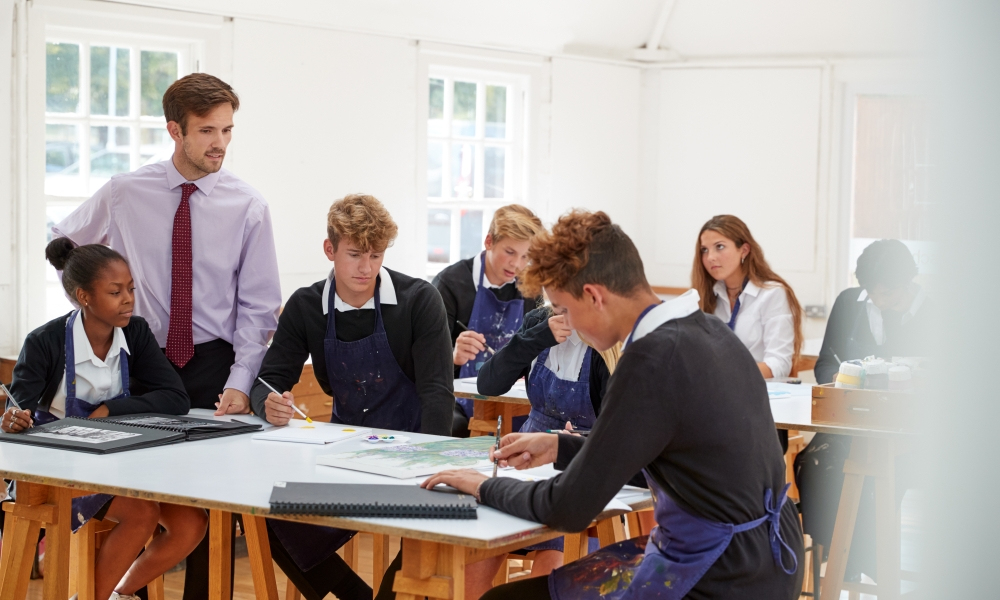Preparing students for life and the workforce includes equipping them with skills such as problem solving, collaboration, and critical and creative thinking. How do these capabilities develop over time, and what do they look like in terms of teaching and assessment?
School leaders and staff at Eltham High School, in north-east Melbourne, have been grappling with these questions for the best part of a decade. Loren Clarke (Curriculum and Data Leader) and Melissa Hughes (Head of Junior School) have been sharing details of the work that's already been done, and the ongoing development, with delegates at Research Conference 2019.
Breaking down subject silos
The foundations for embedding teaching and assessment of these skills across the curriculum had already been laid. Clarke and Hughes explain that, prior to the introduction of the general capabilities, the school made a decision move away from siloed disciplines and content. It was a shake up that involved the reworking of the curriculum structure.
‘When we embarked on this journey a little over 10 years ago, some people were raising some eyebrows and wondering what we were doing,' Hughes tells Teacher. ‘At that time, we felt a bit like pioneers – we had a team of teachers who were carving out the space, carving out the curriculum and turning everything upside down.
‘We were fortunate because we were able to sail forward – that was the permission that we were given by the school leadership, to do things differently, and by the time everybody else was interested a lot of the teething problems had been ironed out.'
That continued interest over the last six years has been from international, national and local classroom teachers and leaders who are keen to make contact and visit Eltham High to find out more. The school has also featured in a Victorian education department case study.
Developing a continuum
In their Research Conference paper, Clarke and Hughes point out the Australian Curriculum and Victorian Curriculum both articulate these general capabilities students need to develop, but exactly how and where these skills are taught is a decision for each school (Clarke & Hughes, 2019).
At Eltham High School, a focus on the teaching of thinking, communication, collaboration, problem solving and innovation was achieved through the Year 7 Integrated Studies Program – a curriculum underpinned by inquiry model informed by the work of Kath Murdoch.
The theme for Research Conference 2019, hosted by the Australian Council for Educational Research (ACER), is ‘Preparing students for life in the 21st Century: Identifying, developing and assessing what matters'.
Clarke says the work that had already been done in restructuring the curriculum meant the school was in a great place to develop a continuum for these capabilities. ‘You actually have to start from: What does the curriculum look like now? What do we want it to look like? How do we get there? How do we break down some of those barriers.
‘It took several years of actually doing work in the classroom with kids around the capabilities and doing work around our interdisciplinary learning to be able to see what the continuum might even look like.'
This process culminated at the end of last year with a review and update involving teachers in the Year 7 Integrated Studies Program, interdisciplinary subjects in Year 9 and extended investigation at VCE (Victorian Certificate of Education) level. Clarke says extending the focus across the year levels meant it could be used as a genuine continuum throughout secondary school, with students entering and exiting at different points rather than being tied to their year level.
‘So, we had a team of teachers across last year working on that project quite intensively. Alongside that, reviewing what it meant in terms of the inquiry model that we use. One of the key things that came out of it is we've moved away from year level descriptors [for development of the skills] – so, it doesn't say Year 7, 8, 9, 10, it says “emerging”, “consolidating” and “established”. We wanted it to be a point of development for students to understand the next step, but also for teachers to be able to differentiate what they were doing in the classroom.'
Hughes says reviewing the continuum and building it based on their own experience and context, staff drew heavily on Australian Curriculum and Victorian Curriculum. ‘Really trying to use what we do in the school to validate or affirm those descriptors that are in [national and state] documentation as well.'
Teaching routines and strategies to support students
The colleagues say knowing what these capabilities look like, and what growth looks like, allows time to teach routines and strategies that enable students to demonstrate their skills and progress. In their conference paper, they explain: ‘As teachers, we work to uncover the various thinking, communication and collaboration routines that support students as they go about this kind of intellectual work. When we find gaps, we create new routines and through trial and error, evaluate, refine and improve on these with each new cycle of teaching and learning.'
These routines and strategies include KWL (What do you know? What do you want to know? What did you learn?), classroom debates, pushing students to give evidence and to reason by asking ‘Why?', journal writing and Socratic circles.
Finding the time and space
These tools and strategies are taught explicitly through the Year 7 program and, because the focus is embedded throughout the curriculum and across the year levels, students continue to engage with them as they move through school. This integration makes it possible, from a teaching time aspect. ‘We have lots of discussion about the ‘curriculum pie', and certainly right at the beginning when we really shook things up at Year 7 there were some real challenges about how people were prepared to relinquish time that they previously had attached to their curriculum area,' Hughes recalls.
‘And, I think it's an ongoing conversation, but it's about making sure that we still have the opportunity to use the content, but the content is how we teach the skills and not the other way around. So, the priority is on the capabilities.
‘We keep revisiting that and talking about: What are the skills of your content area? And really, it's there in our curriculum. Our curriculum is not a content-based curriculum …. it's a skills-based curriculum, and how you choose to teach those skills is really relatively arbitrary. It's just making people realise that it's not about Ancient Egypt, it's about being able to research using sources that are valid and know how to think critically about those. And, whether it's Ancient Egypt or Ancient China, or the Gold Rush – whatever it is people seem to be initially quite attached to – it's relatively arbitrary.
‘The circulation and publication of the continuum – work that we did done last year – is really helping us to be able to plan for how we're implementing this across the school … and it's more likely now that there's going to be a guaranteed consistency [in terms of what students experience].'
Clarke adds that, as the general capabilities became an education department requirement for assessment and reporting, the school made a conscious decision that those capabilities don't sit with a particular faculty area. ‘Instead of saying, for example, “well Maths is going to take care of critical and creative thinking, English is going to do personal and social” and so on, at different year levels those capabilities fit into different subject areas in different ways.
‘We have a map of how the capabilities fit in with our subjects, and that's a conscious decision so that teachers and students are engaged with them at different points and that they're explicitly taught and assessed in a range of different ways. In the end that's what they're designed to be – general, across all the subjects, and underpinning everything.'
Developing assessment rubrics
Another challenge (for all schools) is how to assess these capabilities. For whole-school assessments, Eltham is using a number of tools, including the ACER Critical Thinking tests for Years 7-10 and ATC21S Collaborative Problem Solving tool (developed through a project led by the University of Melbourne). ‘Some of those are quite conscious choices at the whole-school level because we want to be able to track, longitudinally, what's happening at particular year levels and how those skills develop over a number of years,' Clarke explains.
At a classroom level, staff have created their own rubrics and assessments, drawing on the state and national curriculum documents. Clarke says the emphasis here has been on breaking down some of the higher level rubrics that exist to make the language more accessible and put it into a classroom context. ‘We're constantly reviewing those, because it is hard to capture the complexity of the skill (and how it develops) in something that a teacher can then use to assess in a range of different subjects.'
‘There's been some really great conversations about if we're using an assessment rubric in Art and we score a student as being really high in their assessment in the area of “creative thinking”, and then next year it's the English teacher or the Maths teacher who's using that same assessment rubric, do we have confidence that the student who is demonstrating high ability in that domain area is going to have that same ability in another discipline?,' Hughes adds. ‘That [research] is live and in action now … our gut says it's going to be consistent across the domains, but we're not sure about that.'
Clarke says another continued focus, at a curriculum level, is how to make sure there is a consistent emphasis across the year levels on inquiry and interdisciplinary learning. ‘We have really strong programs for students at Year 7, at Year 9, and we have offerings at VCE through extended investigation. But one of the things we've noticed is that if you don't have that continuous exposure to those skills and that style of learning all the way through, you lose the consistent application of the skills and the skills don't develop as quickly.'
Clarke and Hughes share examples of the inquiry model, skills progression and rubrics, in their conference paper – Teaching and assessing the general capabilities in a secondary school context.
Educators who want to find out more or arrange a visit to the school are also invited to contact them by email (Loren Clarke CLR@elthamhs.vic.edu.au; Melissa Hughes HUH@elthamhs.vic.edu.au).
References
Clarke, L. & Hughes, M. (2019) Teaching and assessing the general capabilities in a secondary school context. 2009 - 2019 ACER Research Conferences. 1.
https://research.acer.edu.au/research_conference/RC2019/5august/1
How much focus does your school give the general capabilities? To what extent do you draw on the curricula in reference to development of these skills?
What tools and resources do you use to map and monitor progress? Do they link to your context and how often are they reviewed?



